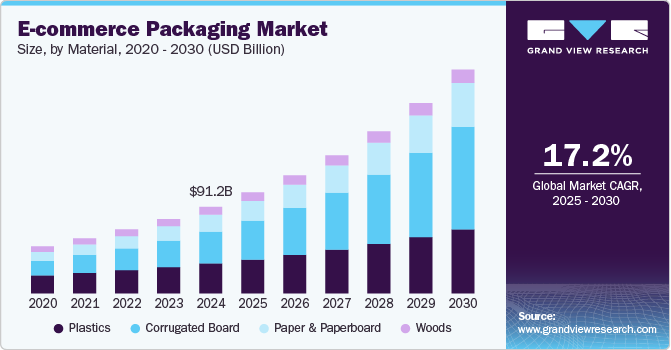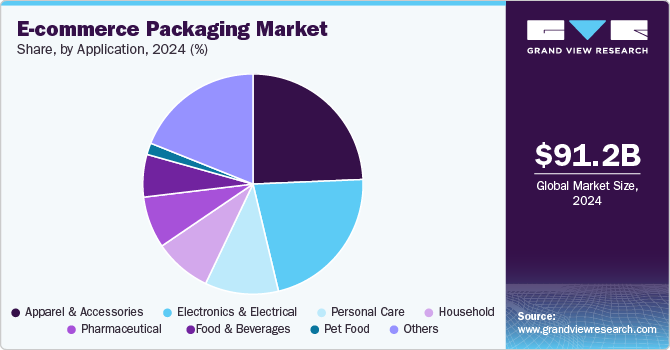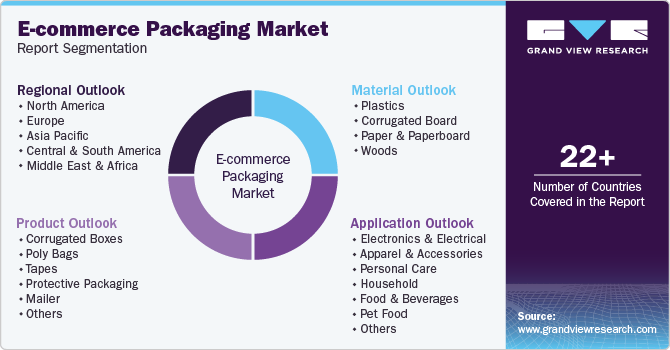
E-commerce Packaging Market Size, Share & Trends Analysis Report By Material (Plastics, Corrugated Board, Paper & Paperboard, Woods), By Product, By Application, By Region, And Segment Forecasts, 2025 - 2030
- Report ID: GVR-4-68039-998-9
- Number of Report Pages: 150
- Format: PDF, Horizon Databook
- Historical Range: 2018 - 2023
- Forecast Period: 2025 - 2030
- Industry: Bulk Chemicals
E-commerce Packaging Market Trends
The global E-commerce packaging market size was valued at USD 91.22 billion in 2024 and is projected to grow at a CAGR of 17.2% from 2025 to 2030. The e-commerce packaging market is experiencing substantial growth, primarily driven by the rapid expansion of the e-commerce sector. Additionally, increasing internet penetration, smartphone usage, and convenience in shopping have led consumers to gravitate toward online purchasing, thus driving the market growth.

As consumer awareness of environmental issues intensifies, sustainability is a critical driver for the e-commerce packaging market. E-commerce giants, driven by both consumer pressure and regulations, are committing to reducing plastic waste, minimizing packaging material usage, and integrating recyclable and compostable options into their packaging solutions. As a result, companies are adopting eco-friendly materials like paper-based packaging, biodegradable plastics, and reusable boxes. This shift aligns with brands’ efforts to enhance their green credentials and appeal to environmentally conscious consumers, further influencing packaging strategies and production standards across the industry.
The increase in product customization and differentiation also drives the e-commerce packaging market. Brands aim to enhance the unboxing experience, which has become an essential aspect of e-commerce, particularly for premium products and sectors such as cosmetics, electronics, and fashion. Companies are investing in packaging that provides a memorable first impression through aesthetic and functional elements, such as easy-open designs, secure closures, and aesthetically pleasing prints. This approach not only protects products but also supports brand building and customer retention in a highly competitive market by making the customer experience more enjoyable and personalized.
Advances in automation and smart packaging technologies are also propelling growth, as companies look to streamline fulfillment processes and reduce labor costs. Automated packaging solutions and integrated systems optimize warehouse management and improve operational efficiency, which is crucial for handling high order volumes during peak seasons. Furthermore, smart packaging technologies, such as QR codes and near-field communication (NFC), are being incorporated to enhance product traceability, anti-counterfeiting measures, and customer engagement, adding a layer of security and interactivity to the consumer experience.
Product Insights
The corrugated boxes segment recorded the largest market revenue share of over 35.0% in 2024. Corrugated boxes are one of the most widely used packaging options in e-commerce due to their strength, durability, and ability to protect items during transit. These boxes are structured with layers of fluted paper, providing cushioning against shocks and vibrations. They are highly customizable, allowing retailers to use various shapes and sizes to fit diverse product types, from electronics to clothing.
Poly bags are lightweight, flexible, and cost-effective, making them suitable for smaller, non-fragile items like apparel and accessories. These bags often come with self-sealing adhesive strips, simplifying the packaging process and enhancing shipping efficiency. Poly bags are also waterproof, which offers additional protection against moisture and humidity during transport.
Mailers are padded or non-padded envelopes used primarily for smaller or flat items, such as books, documents, and small electronics. They are a lightweight alternative to boxes, reducing shipping costs. Mailers can be made from various materials, including paper and plastic, and generally include bubble wrap or foam padding for additional protection.
Material Insights
The corrugated board segment accounted for the largest market share of over 36.0% in 2024. Corrugated board is a top preference for e-commerce due to its strength and recyclability, commonly used for shipping boxes and sturdy packaging materials. Its ability to cushion products against potential shipping damages makes it indispensable for a wide variety of items, from electronics to fragile goods.
Plastics play a substantial role in e-commerce packaging, particularly for items needing waterproofing or secure wrapping. Lightweight and flexible, plastic packaging options, such as bubble wrap, poly mailers, and air pillows, provide robust protection during transit. However, environmental concerns are increasingly influencing the types of plastic materials used, with a shift toward biodegradable and recyclable alternatives gaining traction among retailers.
Paper and paperboard are widely used for secondary packaging, such as inner wrapping, envelopes, and smaller product containers. As sustainable packaging becomes increasingly critical in e-commerce, paper and paperboard have seen rising demand due to their renewable, recyclable, and biodegradable qualities. They are often used as fillers or cushioning, adding an eco-friendly layer of protection inside boxes.
Application Insights
The apparel & accessories segment recorded the largest market share of over 24.0% in 2024. The rapid growth of online shopping, accelerated by trends such as fast fashion and direct-to-consumer (DTC) sales, is driving demand for apparel packaging. Brand differentiation, combined with the growing trend toward sustainable packaging, encourages companies to adopt materials such as recycled cardboard and biodegradable plastics.

Pharmaceutical packaging includes solutions for over the counter (OTC) medications, prescription drugs, and health supplements. Packaging in this category prioritizes security features, such as tamper-evident seals, child-resistant closures, and labeling for regulatory compliance. The increasing adoption of online pharmacies, spurred by greater access to healthcare and the popularity of health and wellness products, is driving demand in this segment.
The electronics and electrical segment encompass packaging solutions designed to protect delicate electronic devices and electrical components during transit. This includes smartphones, laptops, gaming consoles, and home appliances, all of which are prone to damage from shocks, static, or moisture. The increasing adoption of consumer electronics, driven by technological advancements and digitalization, is boosting demand in this segment.
Region Insights
Asia Pacific e-commerce packaging market dominated and accounted for the largest revenue share of over 49.0% in 2024. The Asia Pacific region's dominance in e-commerce packaging is primarily driven by its massive consumer base, rapid digital adoption, and growing middle class. Countries such as China, India, Indonesia, and Vietnam have seen unprecedented growth in online shopping, accelerated by increased smartphone penetration and improved internet infrastructure. For example, China dominates the global e-commerce sales, with platforms such as Alibaba and JD.com handling billions of packages annually, creating massive demand for packaging solutions.

China E-commerce Packaging market is primarily driven by its robust manufacturing ecosystem and advanced packaging infrastructure. The country is investing heavily in automated packaging facilities, smart logistics centers, and research into new materials. The concentration of manufacturing capabilities allows for rapid scaling and cost-effective production, making China a key supplier of packaging materials to both domestic and international markets.
North America E-commerce Packaging Market Trends
The North America E-commerce Packaging market growth is primarily driven by its advanced digital infrastructure, high internet penetration rates, and strong consumer purchasing power. The region, particularly the U.S., has seen explosive growth in online shopping, accelerated by the shift in consumer behavior during recent years. Major retailers such as Amazon, Walmart, and Target have invested heavily in their e-commerce operations, driving significant demand for innovative packaging solutions. The region's robust logistics network and advanced supply chain management systems have also contributed to this growth.
The U.S. E-commerce Packaging market is primarily driven by innovation in packaging technology and sustainability initiatives. Companies are investing significantly in smart packaging solutions, such as Amazon's "Frustration-Free Packaging" program, which has influenced the entire industry. Major retailers are also responding to consumer demand for eco-friendly packaging options, with initiatives to reduce plastic usage and increase recyclable materials.
Europe E-commerce Packaging Market Trends
In Europe, the growth of the e-commerce packaging market is primarily due to its strong environmental regulations and sustainability initiatives. The European Green Deal and the Circular Economy Action Plan have pushed retailers and packaging manufacturers to adopt eco-friendly solutions. For instance, companies such as H&M and Zara have implemented recyclable and reusable packaging programs, while Amazon Europe has eliminated single-use plastic packaging in its fulfillment centers across multiple European countries.
E-commerce Packaging market in the Germany is primarily driven by its strict environmental regulations, particularly the Packaging Act (VerpackG), which have pushed companies to adopt eco-friendly packaging solutions. Besides, the country has one of Europe's largest e-commerce markets, with majority of its population shopping online regularly. Major German retailers such as Zalando and Otto, along with Amazon's strong presence, have created sophisticated logistics networks that demand innovative packaging solutions, thus driving the market growth in the region.
Key E-commerce Packaging Company Insights
The e-commerce packaging market is highly competitive. Key players range from established packaging manufacturers to specialized firms focusing on sustainable materials, customized packaging solutions, and technology-enabled logistics. Companies are differentiating through innovations in lightweight, durable, and biodegradable materials, while addressing concerns such as protection during transit, environmental impact, and reducing packaging waste. Competitive pressures are intense, with firms striving for cost-efficiency and unique designs to enhance customer satisfaction and brand recognition.
Key E-commerce Packaging Companies:
The following are the leading companies in the e-commerce packaging market. These companies collectively hold the largest market share and dictate industry trends.
- Amcor plc
- Berry Global Group, Inc.
- CCL Industries
- Coveris
- Sealed Air
- Sonoco Products Company
- WINPAK Ltd.
- Alpha Packaging
- Constantia Flexibles
- Mondi
- Gerresheimer AG
- Silver Spur Corp.
- Greif
- Transcontinental Inc.
- ALPLA
View a comprehensive list of companies in the E-commerce Packaging Market
Recent Developments
-
In March 2024, Reedbut Group, a UK packaging manufacturer, launched a new range of exclusive e-commerce packaging products, such as cardboard mailers, mail-wraps, and cardboard inserts. This launch is significant as it reflects the growing demand for innovative packaging solutions tailored to e-commerce needs.
-
In November 2023, Sealed Air launched a new line of inflatable air cushions designed for e-commerce packaging, emphasizing sustainability by incorporating at least 95.0% recycled plastic in their construction. This innovative product aims to enhance the unboxing experience while also addressing environmental concerns associated with traditional packaging materials in e-commerce packaging market.
Global E-commerce Packaging Market Report Scope
|
Report Attribute |
Details |
|
Market size value in 2025 |
USD 106.45 billion |
|
Revenue forecast in 2030 |
USD 235.84 billion |
|
Growth rate |
CAGR of 17.2% from 2025 to 2030 |
|
Historical data |
2018 - 2023 |
|
Forecast period |
2025 - 2030 |
|
Quantitative units |
Revenue in USD million/billion and CAGR from 2025 to 2030 |
|
Report coverage |
Revenue forecast, competitive landscape, growth factors, and trends |
|
Segments covered |
Material, product, application, region |
|
States scope |
North America; Europe; Asia Pacific; Central & South America; and Middle East & Africa |
|
Key companies profiled |
Amcor plc; Berry Global; Inc.; CCL Industries; Coveris; Sealed Air; Sonoco Products Company; Winpak Ltd.; Alpha Packaging; Constantia Flexibles; Mondi; Gerresheimer AG; Silver Spur Corp.; Grief; Transcontinental Inc.; ALPLA |
|
Customization scope |
Free report customization (equivalent up to 8 analyst’s working days) with purchase. Addition or alteration to country; regional, and segment scope. |
|
Pricing and purchase options |
Avail customized purchase options to meet your exact research needs. Explore purchase options |
Global E-commerce Packaging Market Report Segmentation
This report forecasts revenue growth at a global level and provides an analysis of the latest industry trends in each of the sub-segments from 2018 to 2030. For this study, Grand View Research has segmented the global e-commerce packaging market report based on material, product, application, and region:

-
Material Outlook (Revenue, USD Million, 2018 - 2030)
-
Plastics
-
Corrugated Board
-
Paper & Paperboard
-
Woods
-
-
Product Outlook (Revenue, USD Million, 2018 - 2030)
-
Corrugated Boxes
-
Poly Bags
-
Tapes
-
Protective Packaging
-
Mailer
-
Others
-
-
Application Outlook (Revenue, USD Million, 2018 - 2030)
-
Electronics & Electrical
-
Apparel & Accessories
-
Personal Care
-
Household
-
Food & Beverages
-
Pet Food
-
Pharmaceutical
-
Others
-
-
Region Outlook (Revenue, USD Million, 2018 - 2030)
-
North America
-
U.S.
-
Canada
-
Mexico
-
-
Europe
-
Germany
-
France
-
UK
-
Italy
-
Spain
-
-
Asia Pacific
-
China
-
India
-
Japan
-
Australia
-
South Korea
-
Southeast Asia
-
-
Central & South America
-
Brazil
-
Argentina
-
-
Middle East & Africa
-
South Africa
-
Saudi Arabia
-
UAE
-
-
Frequently Asked Questions About This Report
b. The global e-commerce packaging Market was estimated at USD 91.22 billion in the year 2024 and is expected to reach USD 106.45 billion in 2025.
b. The global e-commerce packaging market is expected to grow at a compounded annual growth rate of 17.2% from 2025 to 2030 to reach USD 235.84 billion in 2030
b. The apparel and accessories application commanded the largest share of 25.3% in 2024. The factors attributed to driving the market are the rising trend of fast fashion, rising disposable income, and the convenience of having products at the doorstep without the hustle of stores.
b. Amcor plc; Berry Global, Inc.; CCL Industries; Coveris; Sealed Air; Sonoco Products Company; WINPAK LTD.; Alpha Packaging; Constantia Flexibles Group GmbH; Gerresheimer AG; Mondi plc; Silver Spur Corporation; Greif; Transcontinental Inc; ALPLA.
b. Growing e-Commerce retail platforms and technology advancements such as 5G and wider geographic internet connectivity are increasing the e-commerce market.
We are committed towards customer satisfaction, and quality service.
"The quality of research they have done for us has been excellent."




